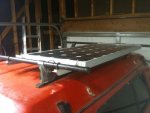tjohns1006
New member
hello there. i have been lurking a while in a few different categories. currently i am thinking about doing a full on solar / dual battery with inverter setup in my 2001 4.7L tundra. i want something that is VERY user friendly, uncomplicated, low maintenance, reliable, etc. i also want to hear your recommendations as far as product suggestions and items that have 'proven themselves' in the field.
i have a fair understanding of electricity but i don't want to piece together a system on my own with all of the 'little' pieces. based on what i know, i need the following items - two batteries (should they match or use a different accessory battery), isolator, dual battery control system (i want ease of use and guages), solar panel (i want to go the rollup route, any brand suggestions ?), an inverter (enough to charge and power a netbook, LED lighting, cell phone, future fridge, etc).
what am i missing ? what size inverter will i need ? what size solar panel ? do i need a separate solar charge controller ? will i need an upgraded from stock alternator ?
anyone willing to draw up a wiring diagram and parts list ? or is there a thread on this already ?
thank you all in advance for your input and suggestions. ballpark of what all this will cost ?
tom
i have a fair understanding of electricity but i don't want to piece together a system on my own with all of the 'little' pieces. based on what i know, i need the following items - two batteries (should they match or use a different accessory battery), isolator, dual battery control system (i want ease of use and guages), solar panel (i want to go the rollup route, any brand suggestions ?), an inverter (enough to charge and power a netbook, LED lighting, cell phone, future fridge, etc).
what am i missing ? what size inverter will i need ? what size solar panel ? do i need a separate solar charge controller ? will i need an upgraded from stock alternator ?
anyone willing to draw up a wiring diagram and parts list ? or is there a thread on this already ?
thank you all in advance for your input and suggestions. ballpark of what all this will cost ?
tom

